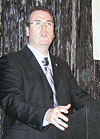
Johnson Controls’ John Murphy welcomes attendees to the Intelligent Buildings Executive Summit, which drew close to 150 attendees.
Those were some of the wide-ranging issues that made up much of the Intelligent Buildings Executive Summit hosted by Johnson Controls at both its corporate headquarters in Glendale, Wis., and at its Building Efficiency headquarters in downtown Milwaukee.
The event drew close to 150 of the company’s customers for two days of talks and seminars on energy and industry topics; a tour of the Glendale campus, where engineering and environmental innovations had the facility headed for Platinum certification in the Leadership in Energy and Environmental Design (LEED) program; an intelligent building technology expo; and a social event at Miller Park, home of the Milwaukee Brewers, where Johnson Controls technology is used.
Attendees were welcomed by John Murphy, vice president and general manager for Systems in North America, Latin America, Middle East and Global Security and Strategy for Building Efficiency. He noted energy issues “are creating a perfect storm of sources to create a more powerful management system” for buildings.
Joe Walicki, vice president and general manager, North America, Systems, told attendees it was Johnson Controls’ intention to provide “the latest knowledge to make your facilities more comfortable, energy efficient, and sustainable.”
He noted that along the way, there is a learning curve in the process. “Integrated building systems and services bridge the gap between technology and construction. Many technology companies don’t understand construction, and many construction companies don’t understand technology. Yet, building and IT systems are continuing to converge.”
REGULATORY PRESSURE
The regulatory aspect of the energy equation was also noted by Walicki. Among trends, he said, were updated commercial/residential building codes that were expected to require higher energy efficiencies, voluntary ‘green’ building codes with incentives for exceeding codes, and retrofit incentives including those for early retirement of chillers and unitary equipment using CFCs.While the current economy is showing a decline in commercial construction starts, the federal government is infusing money into America’s infrastructure. And, he said, there will continue to be emphasis on social responsibility, reducing equipment costs, and reducing the carbon footprint of a building.
Konkana Khaund, an industry analyst from Frost & Sullivan, a consulting company, echoed the emphasis on efficiencies saying, “Green is being looked at as a way to get out of the economic gloom.” She described energy efficiency as “the real future of green growth.” And she added that there is a “pressing need” for such efficiencies given that “buildings are responsible for 40 percent of the world’s total energy and account for 25 percent of CO2 emissions, with HVAC accounting for the largest part of a building’s energy use.”
The importance of a convergence of building systems and IT technology is critical, she said, otherwise “we will just continue to see reactive technology.”

Joe Walicki, vice president and general manager of North America, Systems, said, “Building and IT systems are continuing to converge.”
A PLATINUM PANEL
A number of persons involved in LEED work at the Glendale campus outlined what was called “an integrated approach to developing the most sustainable multibuilding campus in the country.”The work at the 33-acre site included the gutting and renovating of two buildings with 134,000 square feet and new construction involving 125,000 square feet. Solar technology was said to provide all hot water needs except for the cafeteria.
The geothermal system included a closed loop heat exchanger, and 272 wells at 300 feet deep that use subsurface temperatures for warming or cooling the water supply. It is predicted that using heat pumps rather than natural gas boilers will reduce winter heating costs by close to 30 percent, and using geothermal for removing condenser heat in the summer will reduce chiller operating costs by 23 percent.
LATEST TECHNOLOGIES
As part of the summit, there was an Intelligent Building Technology Expo, where customers were able to, according to the manufacturer, “experience a ‘day in the life’ of a fully integrated, ‘bright green’ building.” The theme was “learning how your building can reduce cost, risk, and become more intelligent.”Publication date:11/23/2009


Report Abusive Comment